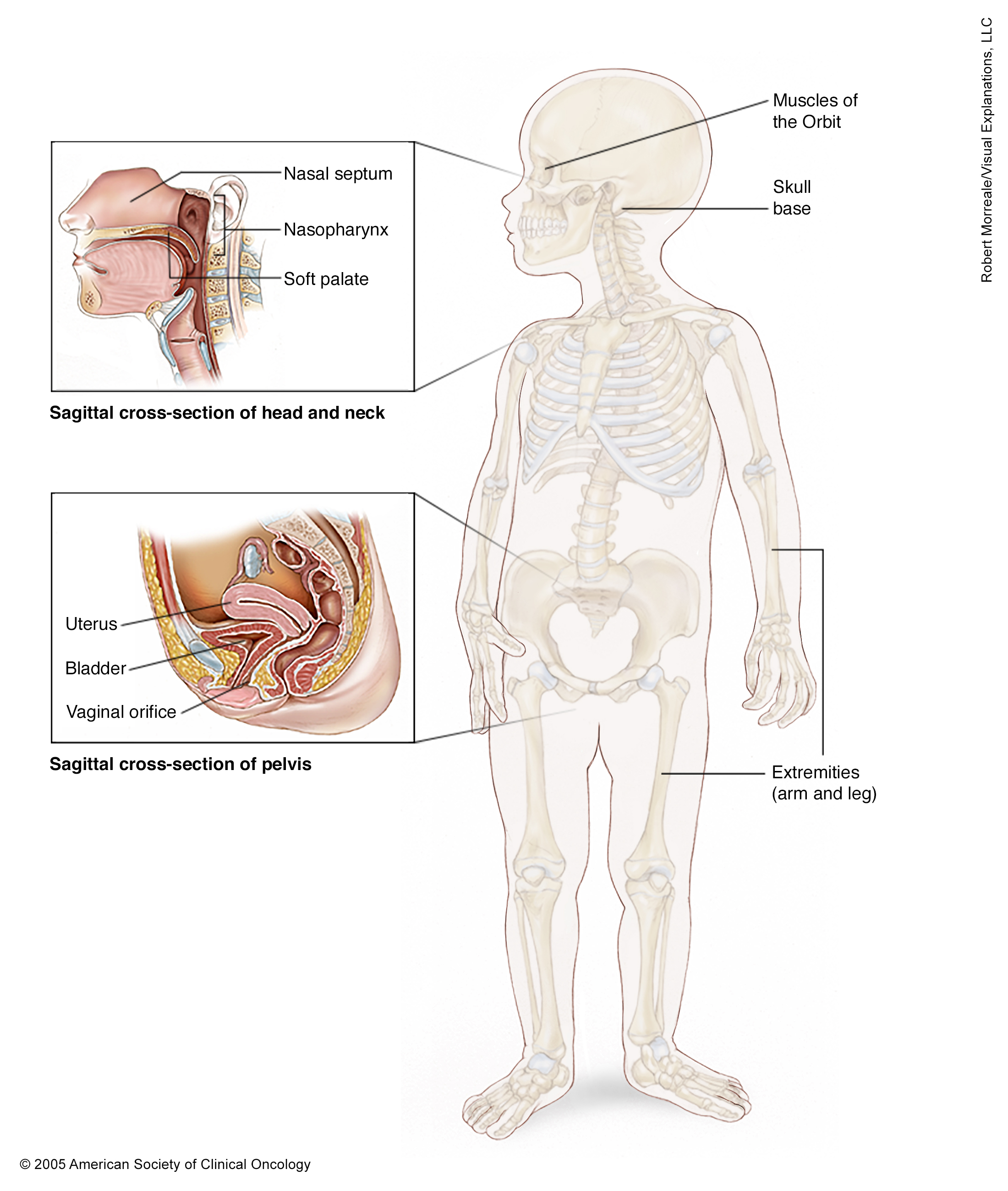ON THIS PAGE: You will find some basic information about this disease and the parts of the body it may affect. This is the first page of Cancer.Net’s Guide to Childhood Rhabdomyosarcoma. Use the menu to see other pages. Think of that menu as a roadmap for this entire guide.
About sarcoma
Soft tissue sarcoma (STS) is a cancer that develops in the tissues that support and connect the body. It can occur in fat, muscle, nerves, tendons, joints, blood vessels, or lymph vessels. Cancer begins when healthy cells change and grow out of control, forming a mass called a tumor. A tumor can be cancerous or benign. A cancerous tumor is malignant, meaning it can grow and spread to other parts of the body. A benign tumor means the tumor can grow but will not spread. In general, sarcomas are uncommon, accounting for about 1% of all cancers.
About rhabdomyosarcoma
Rhabdomyosarcoma is a type of STS that typically begins in early skeletal muscle cells. It develops in a type of muscle called striated muscle, which are the voluntary muscles of the arms, legs, and rest of the body that people can control. Rhabdomyosarcoma is most frequently found in children and young adults.
Rhabdomyosarcoma can occur anywhere in the body, including:
-
Head and neck: About 40% of all rhabdomyosarcoma cases in children. This includes parameningeal sites (near the membranes covering the brain), 25% of cases; eye socket, 8% of cases; and other head and neck locations, 7% of cases.
-
Urinary or reproductive organs: About 30% of cases.
-
Arm or leg: About 15% of cases.
-
Other locations: About 15% of cases. Areas include the trunk (torso), intrathoracic (inside the lung and/or chest), biliary tract, retroperitoneal (the area in the back of the abdomen), pelvic, and perineal sites (close to the anus, vagina, and urinary structures).

Types of rhabdomyosarcoma
Each rhabdomyosarcoma tumor is classified as either favorable or unfavorable based on its histology, which is what the cells look like under a microscope. The terms “favorable” and “unfavorable” refer to the appearance of the cancer cells. In general, the more cancer cells look like normal cells, the more “favorable” they are and the greater the chance that treatment will be successful.
Favorable histology tumors include the following:
-
Embryonal rhabdomyosarcoma. This is the most common type of rhabdomyosarcoma. It is frequently found in the head and neck and in the reproductive and urinary organs.
-
Botryoid rhabdomyosarcoma. This is a subtype of embryonal rhabdomyosarcoma that is found most often in hollow organs, such as the bladder or the vagina.
-
Spindle cell rhabdomyosarcoma. This is another subtype of embryonal rhabdomyosarcoma that is found most often in the area around the testicles.
-
Unfavorable histology tumors include the following:
-
Alveolar rhabdomyosarcoma. This is a more aggressive type of rhabdomyosarcoma that is found most often in an arm, leg, or trunk of the body. An alveolar rhabdomyosarcoma can be subdivided based on its genetic pattern. The doctor will run specialized testing on your child's tumor tissue to determine if there are any unique gene fusions present and may recommend different treatments based on the molecular pattern of your child's tumor (see Types of Treatment).
-
Pleomorphic and undifferentiated rhabdomyosarcoma. These are the rarest types of rhabdomyosarcoma in children. They are found most commonly in an arm, leg, or trunk. This type of rhabdomyosarcoma is more common in adults.
This section covers rhabdomyosarcoma diagnosed in children, also called pediatric rhabdomyosarcoma. Learn more about soft tissue sarcoma in adults.
Looking for More of an Introduction?
If you would like more of an introduction, explore this related item. Please note that this link will take you to another page on Cancer.Net:
-
Cancer.Net Patient Education Video: View a short video on sarcoma led by an American Society of Clinical Oncology (ASCO) expert that provides basic information and areas of research.
-
Find a Cancer Doctor. Search for a cancer specialist in your local area using this free database of doctors from ASCO.
-
Cancer Terms. Learn what medical phrases and terms used in cancer care and treatment mean.
The next section in this guide is Statistics. It helps explain the number of children and teens who are diagnosed with this disease and general survival rates. Use the menu to choose a different section to read in this guide.
